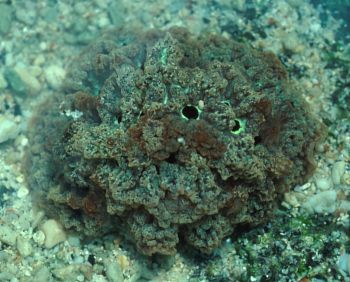
Atagema spongiosa
(Kelaart, 1858)
Order: NUDIBRANCHIA
Suborder: DORIDINA
Superfamily: EUDORIDOIDEA
Family: Dorididae
DISTRIBUTION
Indo-West Pacific
PHOTO
AM C137597, 60 mm long alive. 24 November 1982, Public swimming pool, Christmas Is., Indian Ocean. Photo: John Hicks
Formerly known as Trippa spongiosa. See message
This species is one of a number of dorids with a very sponge-like appearance. One very distinctive feature is the dark purplish underside of its mantle, with a milky green margin. Doris areolata Alder & Hancock, 1864 and Phlegmodoris paagoumenei Risbec, 1928 are two synonyms. It has a wide Indo-West Pacific distribution. Kelaart described it as a large, `semi-gelatinous' species with a deeply pitted mantle. The dorsum [or mantle] is a greenish-brown colour and their are often bluish-green mucous secretions exuding from the skin. The bottom of the deep pits all over the dorsum are sometimes blue-green with black margins and sometimes black with a blue-green marginal ring as in the accompanying photo. grows to at least 12cm long.
Reference:
• Kelaart, E.F. (1858). Description of new and little known species of Ceylon nudibranchiate molluscs and zoophytes. Journal of the Ceylon Branch of the Royal Asiatic Society,
Columbo, 3(1): 84-139.
Rudman, W.B., 2002 (May 15) Atagema spongiosa (Kelaart, 1858). [In] Sea Slug Forum. Australian Museum, Sydney. Available from http://www.seaslugforum.net/find/tripspon
Related messages
Atagema spongiosa from Lord Howe Island
February 15, 2008
From: Margaret Crook
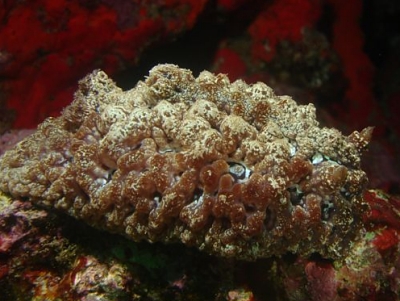
Hi
I found this Atagema spongiosa at Lord Howe Island last week, David Mullins suggested I send it to you to note distribution. I haven't seen one before and it was very well camouflaged.
Locality: Landslide, Malabar - Lord Howe Island, NSW, Pacific, 30 November 2007, Intertidal. Length: approx 120 mm. Photographer: Margaret Crook.
I have a couple of other unusual finds from Lord Howe over recent years & will obtain further details and send to you.
Marg Crook
margaretcrook@westpac.com.au
Crook, M, 2008 (Feb 15) Atagema spongiosa from Lord Howe Island. [Message in] Sea Slug Forum. Australian Museum, Sydney. Available from http://www.seaslugforum.net/find/21260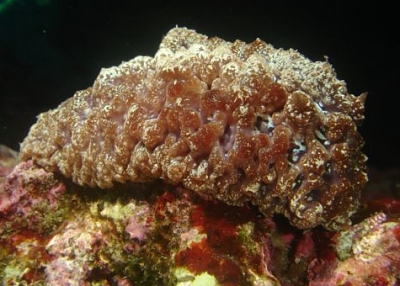
Dear Marg,
Thanks for the record and congratulations on finding it. As you say, "it is very well camouflaged".
I look forward to seeing your other records
Best wishes,
Bill Rudman
Atagema spongiosa? from Anilao, Philippines
August 7, 2006
From: Reindert Grooters and Mieke Snoek
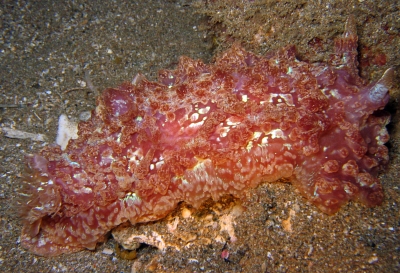
Hello Bill,
Can you identify this big nudibranch (about 18 cm measured with my lamp), which we found during a night dive in Anilao. The big blotches on the further smooth skin seems to be characteristic. The color on the foto's are as we remember: red-brownish with white speckles.
Locality: Anilao, Batangas, 7 metres, Philippines, Pacific, 17 November 2005, Sand and coral patches. Length: 18 cm. Photographer: Mieke Snoek.
Thanks.
Reindert & Mieke
mieke.reindert@chello.nl

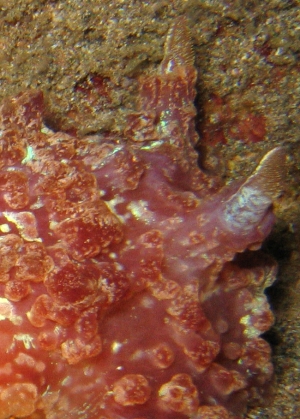
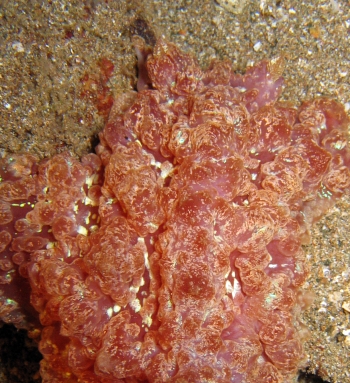
Dear Reindert & Mieke,
I am pretty sure this isAtagema spongiosa . I at first thought it might be some sort of polycerid from its shape, but I am pretty sure that the gills and rhinophores have pocket into which they can contract. I suspect the mantle has been severely damaged, with most of the edge broken or bitten off. The greenish white patches remind me of Atagema spongiosa, as does its large size, so that is my best guess
Best wishes,
Bill Rudman
Big purple-footed nudibranch from Singapore
June 28, 2006
From: Ron Yeo
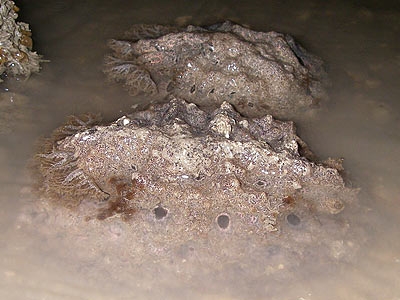
Hi Bill,
Found this big fat nudibranch on an islet which is only exposed during very low tides. The islet is located near an island called Pulau Tekong in Singapore.
Locality: Beting Bronok, Singapore, Singapore, South China Sea, 25 June 2006, Intertidal. Length: 15 cm. Photographer: Ron Yeo.
Would really appreciate it if you can assist to identify it.
Thanks,
Ron Yeo
ronyeo@bigfoot.com
Yeo, R, 2006 (Jun 28) Big purple-footed nudibranch from Singapore. [Message in] Sea Slug Forum. Australian Museum, Sydney. Available from http://www.seaslugforum.net/find/16989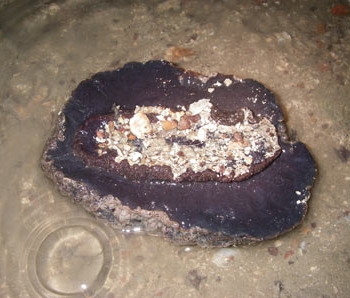
Dear Ron,
The dark purple foot and underside of mantle, and the rows of dark brown spots on the upper side of the mantle, are all good indications of Atagema spongiosa. I have never found two very large animals together like this, but as you no doubt noticed, they are very well camouflaged in their natural environment, so are probably often overlooked.
Best wishes,
Bill Rudman
Atagema spongiosa? from the Philippines
December 21, 2002
From: Erwin Köhler

Dear Bill,
Is the attached photo Atagema spongiosa? It is from the Philippines, Cabilao Island.
Size: 65mm
Depth: 0m (tidepool)
Date: 28 February 2002
Erwin
erwin@medslugs.de
Köhler, E., 2002 (Dec 21) Atagema spongiosa? from the Philippines. [Message in] Sea Slug Forum. Australian Museum, Sydney. Available from http://www.seaslugforum.net/find/8470Dear Erwin,
Certainly looks like A. spongiosa. One useful thing to do when photographing these very cryptic looking animals, which could be a sponge, or Dendrodoris tuberculosa, etc, etc, is to gently turn them over and take a photo of the underside as well. As long as you turn them back - if they aren't already doing that themselves - it should cause them no harm, and would give me a few more clues
Cheers,
Bill Rudman
Trippa spongiosa from Sydney
November 5, 2002
From: Ian Simpson
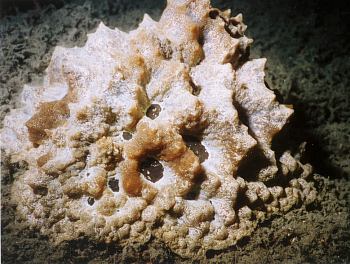
Dear Dr Rudman,
I was hoping that you would be able to identify this opisthobranch. These photos were taken on a night dive at Parsley Bay in Sydney's Eastern Suburbs on 13th January 2002. The depth was approximately 6 metres. Visibility was 4 metres at best. The animal had an almost round base approximately 20cm in diameter. It was first spotted on a night dive one week earlier on 7th January, 2002. However, just as we spotted it my buddy's torch failed and we aborted the dive. A week later we returned to decide whether or not we'd seen an old piece of sponge or an opisthobranch on steroids. On the second dive we found it very close to where it had been a week earlier (ie. within a few metres). It was on an algae covered rock, and the surface of the rock was on about a 45 degree angle to horizontal. We observed the specimen for around one minute before moving in closer to take the photos. During this time it did not move at all, however we were able to determine that it was a living specimen due to it retracting and subsequently extended both its rhinophores and gills. The specimen was symmetrically patterned. There was no obvious 'bare patch' on the rock so I cannot day whether or not it was feeding on the algae. I suspect that it is a Trippa spongiosa.
Are you interested in hearing of further sightings of this species in Sydney Harbour? Not that I have any at the moment, but am planning to go back there soon.
Thanks in advance,
Ian Simpson
barts_computer@hotmail.com
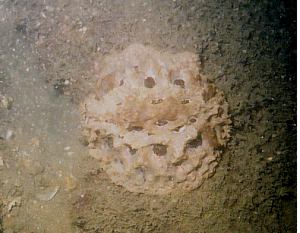

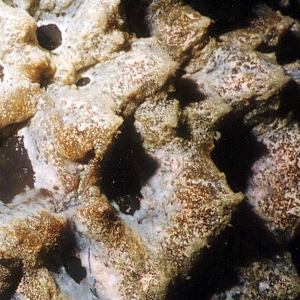
Dear Ian,
Yes this is the well-named Trippa spongiosa. The sponge-like dorsal appearance, including the pits with dark bases, are very characteristic, and range in colour from this khaki brown to a deep green. The underside of the mantle with its uniform purple-brown colouration is also a useful character. Even though it grows quite large, and occurs throughout the Indo-West Pacific, there are not that many records of it being found. I suspect this is because of its excellent camouflage rather than it being a rare species. I am certainly interested in further sightings, but I am particularly interested in observations and photos of any species of opisthobranch 'doing something' - such as laying eggs, feeding etc. In this case it will be feeding on some sponge, but just which species would be of great interest.
Best wishes,
Bill Rudman
Trippa spongiosa from Sth Korea
August 11, 2002
From: Dong Bum, Koh
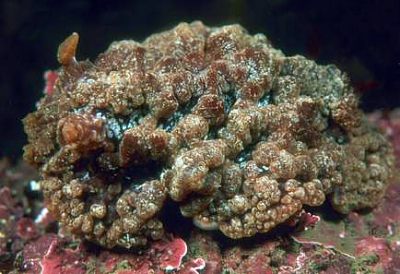
Dear Bill,
Thanks a lot for your identifications. Would you please tell me if this nudibranch is Trippa spongiosa? (scan 501)
Data:
Mun islet. Che Ju Island. Sth Korea.
8 m depth. Oct.2001
Photo: Dong Bum, Koh
Best wishes,
Dong Bum, Koh
drkoh@seasee.co.kr
Koh, D.B., 2002 (Aug 11) Trippa spongiosa from Sth Korea. [Message in] Sea Slug Forum. Australian Museum, Sydney. Available from http://www.seaslugforum.net/find/7653Dear Dong Bum,
Yes this is Trippa spongiosa
Best wishes,
Bill Rudman
Trippa spongiosa from Christmas Island
May 18, 2002
From: W.B. Rudman

Here is a photo of Trippa spongiosa from John Hicks' Christmas Island, Indian Ocean collections.
PHOTO: AM C137597, 60 mm long alive. 24 November 1982, Public swimming pool, Christmas Is., Indian Ocean. Photo: John Hicks
Best wishes,
Bill Rudman
